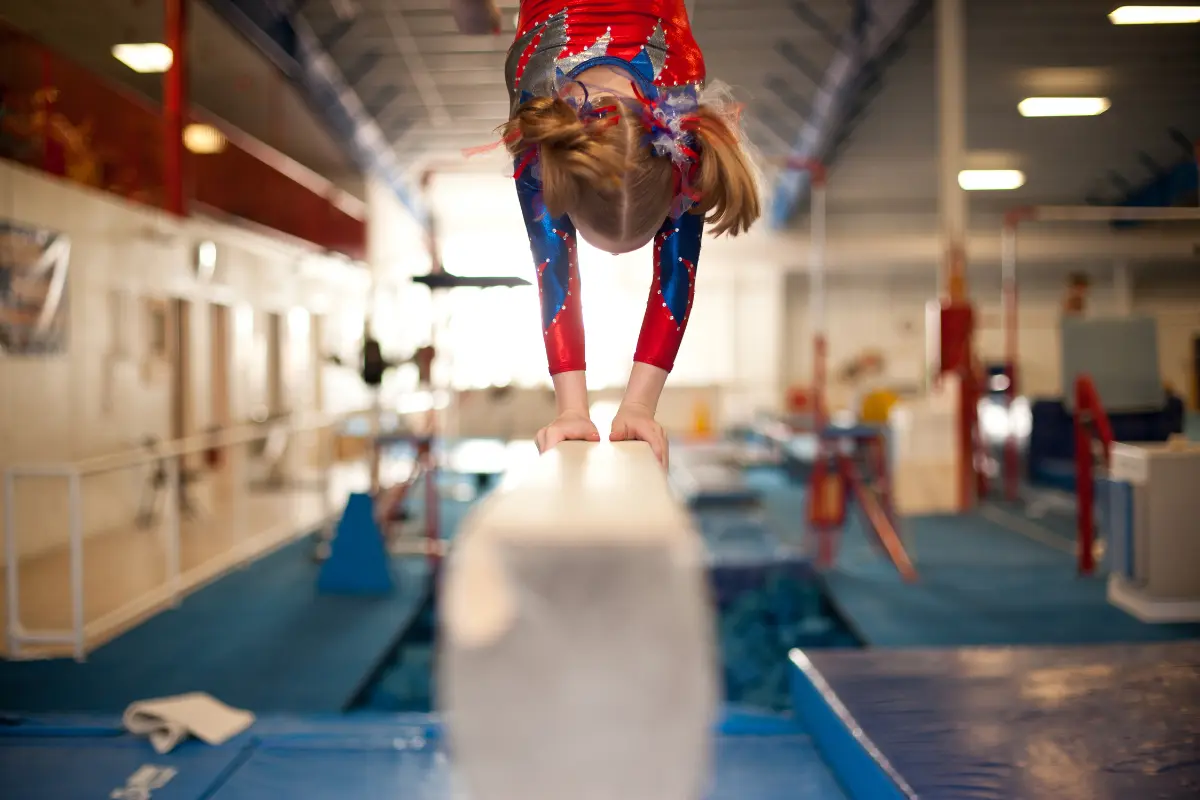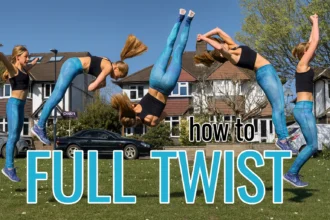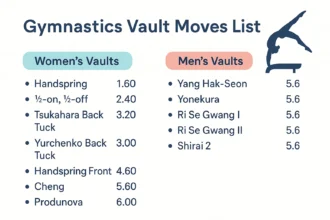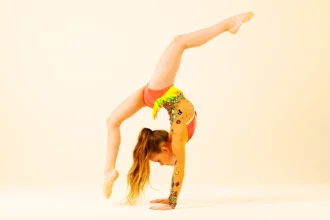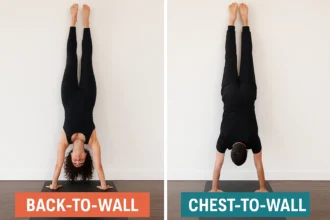Doing a handstand on a balance beam is an impressive gymnastics skill that requires strength, balance, and proper technique. Here’s a step-by-step guide on how to safely learn and execute this skill:
1. Perfect Your Floor Handstand
A floor handstand is the building block for all inverted skills in gymnastics, and mastering it will significantly improve your chances of success on the beam.
Start by developing the necessary upper body and core strength through exercises like push-ups, planks, and hollow body holds. These exercises will help you maintain proper form during your handstand.
Begin practicing against a wall to build endurance and get comfortable with the inverted position. As you progress, work on freestanding handstands, focusing on maintaining a straight body line, pointed toes, and a tight core.
Key points:
- Develop upper body and core strength
- Practice against a wall before attempting freestanding handstands
- Focus on proper form: straight body line, pointed toes, and engaged core
- Aim for consistent 30-second holds
2. Familiarize Yourself with the Beam
Getting comfortable on the balance beam is essential before attempting any advanced skills.
Start by simply walking on the beam, both forward and backward, to get a feel for its dimensions and texture. Practice relevés (rising onto the balls of your feet), arabesques (balancing on one leg with the other extended behind you), and scales (similar to an arabesque but with your torso parallel to the beam) to improve your balance and build confidence.
Incorporate strength exercises like planks and push-ups on the beam to get accustomed to supporting your body weight on the narrow surface. Gradually increase the difficulty of your beam exercises, including turns, leaps, and simple acrobatic elements, to develop a comprehensive feel for the apparatus.
Key points:
- Practice basic movements: walking, relevés, arabesques, and scales
- Perform strength exercises on the beam
- Develop spatial awareness and balance control
- Progressively increase the difficulty of beam exercises
3. Practice Handstand Entries on the Floor
A proper entry ensures that you have the momentum and control necessary to achieve a stable handstand position.
Begin in a lunge position, with your front leg bent and back leg straight. Practice the swing-through technique, where you swing your back leg forward while simultaneously lifting your front leg. This motion should be fluid and controlled.
Focus on reaching your hands to the floor as your legs come together above you, creating a straight line from your hands to your toes. Work on different entry speeds, from slow and controlled to more dynamic, as both can be useful depending on the routine or skill you’re performing.
Key points:
- Master the lunge to handstand entry
- Practice the swing-through technique
- Focus on fluid motion and body alignment
- Experiment with different entry speeds
4. Transfer to a Low Beam
Once you’re comfortable with floor handstands and beam basics, it’s time to start practicing on a low beam or a line on the floor. This intermediate step helps bridge the gap between floor work and the standard beam, allowing you to adjust to the narrower surface gradually.
Work on holding the handstand position for increasingly longer durations, starting with just a few seconds and gradually building up your endurance.
As you gain confidence, start practicing entries from different positions on the beam and experiment with various hand placements to find what feels most comfortable and stable for you.
Key points:
- Use a spotter for initial low beam practices
- Focus on precise hand placement on the beam center
- Gradually increase hold durations
- Practice entries from different beam positions
5. Progress to the Standard Beam
As you gain confidence on the low beam, it’s time to move to a standard-height beam. This transition can be intimidating, so always use mats and a spotter for safety.
Start with assisted handstands, having a spotter support your legs as you get used to the height. This will help you overcome any fear or hesitation. Gradually reduce spotter assistance as you become more comfortable.
Focus on maintaining the same level of control and precision you developed on the low beam. As you become more confident, begin to incorporate the handstand into simple sequences or combinations to simulate its use in a routine.
Key points:
- Use mats and a spotter for safety
- Start with assisted handstands and gradually reduce support
- Practice entries from various beam positions
- Maintain control and precision developed on the low beam
6. Perform the Handstand on the Beam
Executing a handstand on the standard beam requires a combination of all the skills you’ve developed: strength, balance, control, and mental focus.
Begin with your chosen entry technique, whether it’s a lunge entry or a more dynamic kick-up. As you enter the handstand, focus on finding your balance point quickly. Use small adjustments in your fingers and wrists to maintain stability.
Keep your core engaged and your body aligned, imagining a straight line from your hands through your body to your toes. Once in the handstand position, maintain your focus and control. Breathe steadily to help stay relaxed and balanced.
Key points:
- Combine strength, balance, control, and mental focus
- Execute your chosen entry technique with precision
- Find your balance point quickly using finger and wrist adjustments
- Maintain body alignment and core engagement
7. Hold the Handstand
Maintaining balance is key to a successful beam handstand. Once you’ve entered the handstand position, focus on extending your hold times and improving your stability.
Use micro-adjustments in your fingers and wrists to maintain balance. These small movements are crucial on the narrow beam surface. Keep your body aligned vertically over your hands, engaging your core and squeezing your leg muscles to maintain a straight body line.
As you become more comfortable, work on increasing your hold time. Start with a goal of 3-5 seconds and gradually increase it.
Key points:
- Use micro-adjustments in fingers and wrists for balance
- Maintain vertical body alignment over hands
- Practice steady breathing to maintain control
- Gradually increase hold time while maintaining form
8. Dismount with Control
A controlled dismount is crucial for completing your handstand on the beam safely and elegantly. It’s just as important as the entry and hold, and it can significantly impact your overall performance.
Practice various dismount techniques, starting with the most basic: the lunge down. From your handstand position, slowly lower one leg back down to the beam, landing in a lunge position. As you improve, you can progress to more advanced dismounts like cartwheels off the beam or back walkovers.
Always prioritize control over speed or complexity. A clean, controlled dismount will look better and be safer than a rushed or unstable one. Practice your dismounts regularly, giving them as much attention as you do your entries and holds.
Key points:
- Start with basic dismounts like the lunge down
- Progress to more advanced techniques as skills improve
- Prioritize control and precision in all dismounts
- Practice dismounts as frequently as entries and holds
- Always land with stability and grace
9. Refine and Combine Skills
Once you’ve mastered the individual components of a beam handstand – the entry, hold, and dismount – it’s time to refine your technique and combine these skills into fluid sequences.
Work on transitioning smoothly between different elements. For example, practice moving from a handstand directly into a cartwheel or back walkover. This will improve your overall beam routine and demonstrate a higher level of skill and control.
Incorporate your handstand into longer beam sequences, combining it with other skills you’ve learned. This could include dance elements, turns, or other acrobatic moves. Remember to maintain the same level of precision and control in your handstand even when it’s part of a larger routine.
Key points:
- Refine individual components of the beam handstand
- Practice smooth transitions between handstands and other skills
- Incorporate handstands into longer beam sequences
- Maintain precision and control within full routines
With patience, consistent practice, and proper progressions, you’ll soon be able to wow onlookers with a picture-perfect handstand on beam! Always put safety first and happy balancing!


